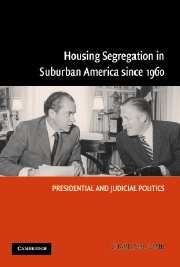Book contents
- Frontmatter
- Contents
- Preface and Acknowledgments
- Abbreviations
- Housing Segregation in Suburban America since 1960
- 1 Separate Worlds, Separate Lives
- 2 Lyndon Johnson and the Fair Housing Act
- 3 George Romney's Blueprint for Suburban Integration
- 4 Richard Nixon, Centralization, and the Policymaking Process
- 5 Suburban Segregation from Gerald Ford to Bill Clinton
- 6 The Federal Courts and Suburban Segregation
- 7 Conclusions
- Appendix
- Bibliography
- Index
4 - Richard Nixon, Centralization, and the Policymaking Process
Published online by Cambridge University Press: 21 November 2009
- Frontmatter
- Contents
- Preface and Acknowledgments
- Abbreviations
- Housing Segregation in Suburban America since 1960
- 1 Separate Worlds, Separate Lives
- 2 Lyndon Johnson and the Fair Housing Act
- 3 George Romney's Blueprint for Suburban Integration
- 4 Richard Nixon, Centralization, and the Policymaking Process
- 5 Suburban Segregation from Gerald Ford to Bill Clinton
- 6 The Federal Courts and Suburban Segregation
- 7 Conclusions
- Appendix
- Bibliography
- Index
Summary
Presidents must frequently overcome bureaucratic resistance to attain their policy preferences. Even without bureaucratic resistance, the implementation process may yield results that differ from a president's desired policies. As a consequence, presidents may develop administrative strategies for influencing public policy and its implementation.
Richard Nixon craved a presidential legacy in foreign policy and initially felt he could leave domestic affairs to his appointees. At the beginning of his administration, Nixon permitted cabinet members in the domestic arena to choose their own program officials as well as to oversee agency policy. Given Nixon's views on suburban housing integration, this approach to presidential control had negative ramifications. Since Nixon's civil rights policy was unfocused at first, George Romney had the leeway to develop controversial housing integration policies that unnerved the very suburbs Nixon would depend on in the 1972 presidential election. Toward the end of his first term, therefore, Nixon profoundly altered his approach to presidential control. He turned to an “administrative presidency” strategy, which assumed that a president could and should play a forceful role in overseeing the bureaucracy in order to promote his domestic policy agenda. The power of cabinet members diminished, and the power of Nixon's most trusted White House lieutenants, H. R. Haldeman and John Ehrlichman, substantially increased. Indeed, Haldeman and Ehrlichman became two of the most powerful men inWashington during the Nixon years.
- Type
- Chapter
- Information
- Housing Segregation in Suburban America since 1960Presidential and Judicial Politics, pp. 108 - 164Publisher: Cambridge University PressPrint publication year: 2005



